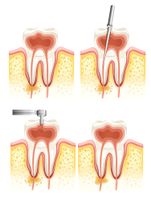Root Canals Vs. Tooth Extractions: What These Procedures Entail

If you’ve been to the dentist recently and have been told you have a badly decaying or damaged tooth, your dental provider may have suggested doing one of two things — performing root canal therapy or doing a tooth extraction. J. Bryson McBratney, D.D.S., a top dentist in Anchorage, AK, says determining which of these two treatment types you’ll need depends on how extensive the damage is and whether or not your dentist thinks the tooth is salvageable.
Root Canal
Root canals are a very common dental procedure and are used to treat badly damaged, decayed, or diseased teeth. During a root canal, a dentist will remove the pulp of the damaged or infected tooth, which is the inner substance of the tooth that provides blood flow. Most often, root canal therapy is required if you have a badly broken tooth, have a substantial crack in it, or if you’ve developed a severe cavity.
 If your dentist has determined your tooth can be saved, they’ll perform a root canal. This process entails numbing the affected area and removing the dead pulp through a small opening in the tooth. Once the pulp is cleaned out, a dentist will fill the tooth with a special dental material. In most cases, a crown is then placed on top of the tooth to restore its appearance and function.
If your dentist has determined your tooth can be saved, they’ll perform a root canal. This process entails numbing the affected area and removing the dead pulp through a small opening in the tooth. Once the pulp is cleaned out, a dentist will fill the tooth with a special dental material. In most cases, a crown is then placed on top of the tooth to restore its appearance and function.
Tooth Extraction
Tooth extractions are also a common dental procedure and are needed when a badly decayed, broken, or damaged tooth cannot be fixed with other treatment options. In some cases, tooth extractions are needed because a particular tooth is blocking another from coming in.
There are two types of tooth extraction procedures — nonsurgical and surgical. Nonsurgical tooth extractions, also called simple extractions, are a procedure that only requires local anesthesia. A dentist will use a special instrument to loosen and remove the tooth from a patient’s mouth.
In more complex cases, an oral surgeon will perform a surgical tooth extraction, which entails making one or multiple incisions in the gum line. While this can be done using local anesthesia, some patients prefer to be given general anesthesia, which puts them to sleep during the entire procedure.
To learn more about root canal therapy and dental extractions, consult Dr. McBratney. You can call his office at (907) 562-3323 to schedule an appointment for an exam. For more information on his practice and the dental care he offers, visit J. Bryson McBratney, D.D.S. online.
About the Business
Have a question? Ask the experts!
Send your question

